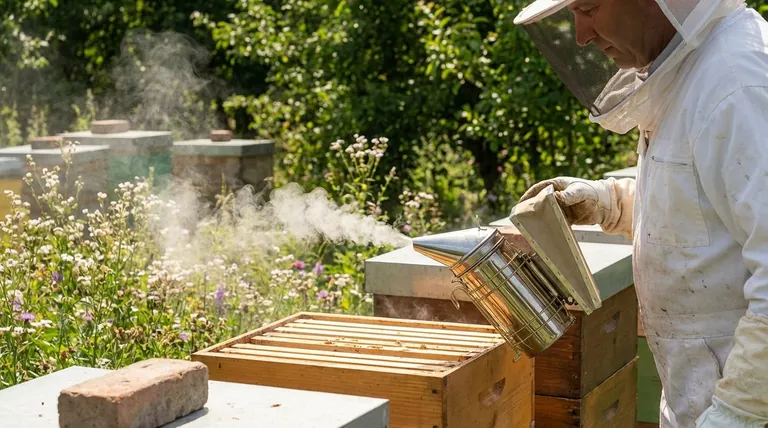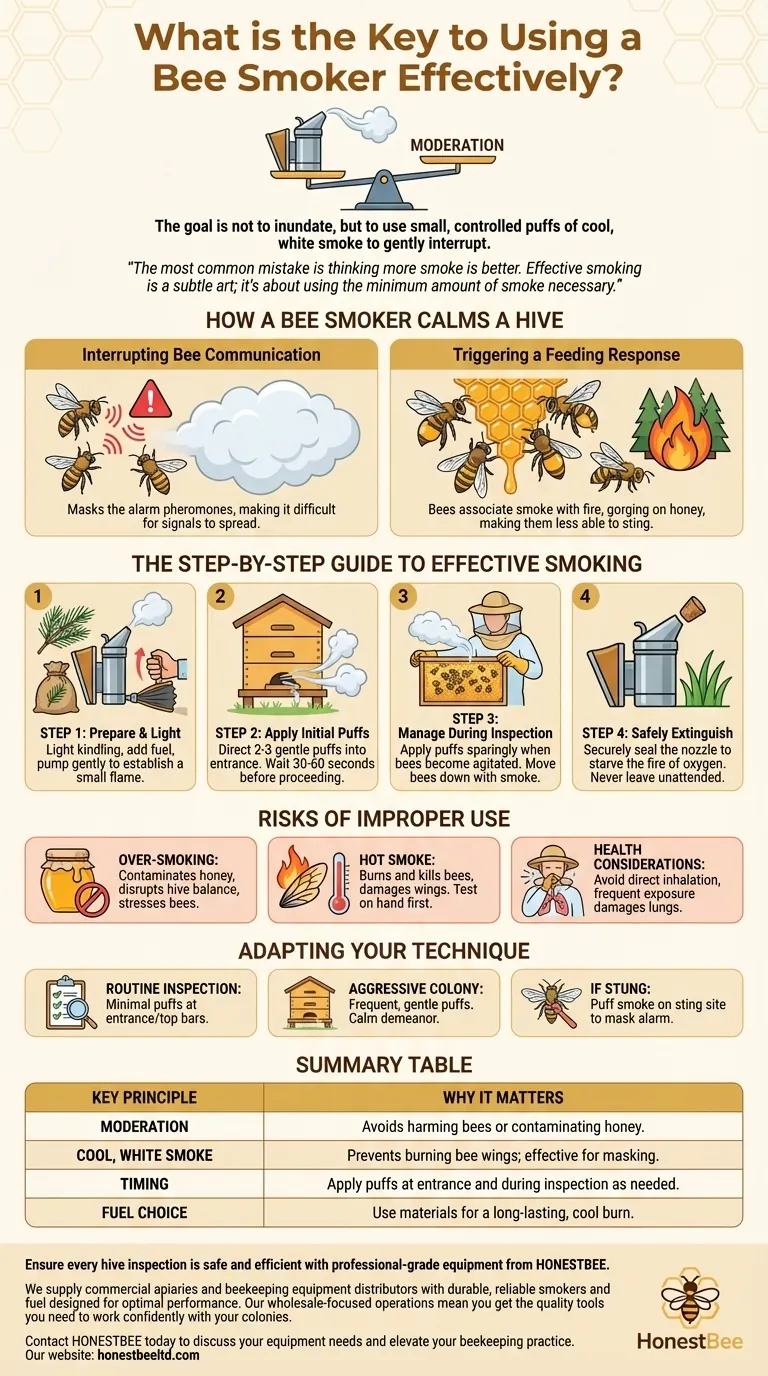The key to using a bee smoker effectively is moderation. The goal is not to inundate the hive with smoke, but to use small, controlled puffs of cool, white smoke to gently interrupt the bees' defensive communication, making your inspection safer for both you and the colony.
The most common mistake is thinking more smoke is better. Effective smoking is a subtle art; it's about using the minimum amount of smoke necessary to mask alarm pheromones, not about overwhelming the bees.

How a Bee Smoker Calms a Hive
A bee smoker is a simple but brilliant tool for controlled combustion. Understanding its purpose is the first step toward mastering its use.
Interrupting Bee Communication
When bees feel threatened, guard bees release an alarm pheromone. This chemical signal alerts other bees to the danger, triggering a defensive response.
The smoke from your smoker doesn't sedate the bees. Instead, it masks the alarm pheromones, making it difficult for the guards' signals to spread through the colony. This interruption prevents a small disturbance from escalating into a full-blown defensive attack.
Triggering a Feeding Response
The presence of smoke also triggers a secondary, instinctual response. The bees associate smoke with a potential forest fire, which would threaten their hive.
In response, they begin to gorge on honey in preparation for potentially abandoning their home. A bee with a full stomach is physically less able to flex its abdomen to sting and is generally more docile.
The Step-by-Step Guide to Effective Smoking
Proper technique ensures the smoke is cool, consistent, and effective without causing harm.
Step 1: Prepare and Light Your Fuel
Start by placing a small amount of kindling, like dry grass or paper, in the bottom of the fire chamber. Light it and give the bellows a few gentle pumps to establish a small flame.
Once the kindling is burning, add your primary fuel, such as pine needles, untreated burlap, or wood pellets. Pack the fuel in loosely enough to allow for airflow but densely enough to last through your inspection.
Step 2: Apply the Initial Puffs
Before you open the hive, direct two to three gentle puffs of smoke into the main entrance. Wait about 30-60 seconds before proceeding.
This initial application alerts the bees to your presence and begins masking any alarm pheromones from the outset.
Step 3: Manage Smoke During the Inspection
After lifting the outer and inner covers, apply another few puffs across the top of the frames. This moves the bees down and allows you to work.
Use smoke sparingly during the inspection. Only apply another puff when you see bees becoming agitated or flying directly at you.
Step 4: Safely Extinguish the Smoker
Once your inspection is complete, securely seal the smoker's nozzle with a cork or a clump of green grass. This starves the fire of oxygen and safely extinguishes it.
Never leave a lit smoker unattended.
Understanding the Trade-offs: The Risks of Improper Use
Using a smoker incorrectly can do more harm than good. Awareness of the potential pitfalls is crucial for responsible beekeeping.
Over-smoking Harms the Colony
Using too much smoke can contaminate honey with a smoky flavor, disrupt the hive's delicate chemical balance, and cause unnecessary stress to the bees and queen.
Hot Smoke is a Critical Danger
Always test the smoke on the back of your hand before applying it to the hive. It should be cool and pleasant.
Hot smoke, produced by a fire that is burning too fast, can burn and kill bees, especially by damaging their delicate wings. Ensure your smoke is white and cool, not gray and hot.
Health Considerations for the Beekeeper
The smoke is for the bees, not for you. Avoid inhaling it directly, as frequent exposure can be damaging to your lungs over time.
Adapting Your Technique to the Situation
Your approach should be flexible and responsive to the temperament of the colony and your specific goal.
- If you are performing a routine inspection: Your goal is minimal disruption. Use just a few puffs at the entrance and a few across the top bars to keep the bees calm.
- If you are dealing with an aggressive colony: Be prepared to use smoke more frequently, but always in gentle puffs. Your calm demeanor is just as important as the smoke.
- If you get stung: Immediately direct a puff of smoke onto the sting site. This will mask the alarm pheromone released from the stinger and help prevent other bees from targeting the same spot.
Mastering the bee smoker is about developing a feel for what the hive needs, turning a potentially stressful interaction into a calm and productive one.
Summary Table:
| Key Principle | Why It Matters |
|---|---|
| Moderation | Avoids harming bees or contaminating honey. |
| Cool, White Smoke | Prevents burning bee wings; effective for masking pheromones. |
| Timing | Apply puffs at the entrance and during inspection as needed. |
| Fuel Choice | Use materials like pine needles or burlap for a long-lasting, cool burn. |
Ensure every hive inspection is safe and efficient with professional-grade equipment from HONESTBEE.
We supply commercial apiaries and beekeeping equipment distributors with durable, reliable smokers and fuel designed for optimal performance. Our wholesale-focused operations mean you get the quality tools you need to work confidently with your colonies.
Contact HONESTBEE today to discuss your equipment needs and elevate your beekeeping practice.
Visual Guide

Related Products
- European Stainless Steel Bee Smoker for Honey Bee Hive
- Stainless Steel Honey Bee Smoker Hive and Honeycomb Smoker for Beekeeping
- Economy Galvanized Beekeeping Honey Bee Smoker for Wholesale
- Premium Traditional Copper Bee Smoker with Bellows
- Electric Bee Smoker European Style Bee Hive Smoker for Beekeeping
People Also Ask
- What are the differences between stainless steel and galvanized steel bee smokers? Choose the Right Smoker for Your Apiary
- Can you use too much smoke on bees? The Right Way to Use a Bee Smoker for Calm Inspections
- What are the features of a recommended bee smoker? A Guide to Safety, Durability & Performance
- What are the key benefits of using a bee smoker? Master Hive Inspections Safely and Efficiently
- What are the benefits of smoking bees? Achieve Safer, Calmer Hive Inspections



















